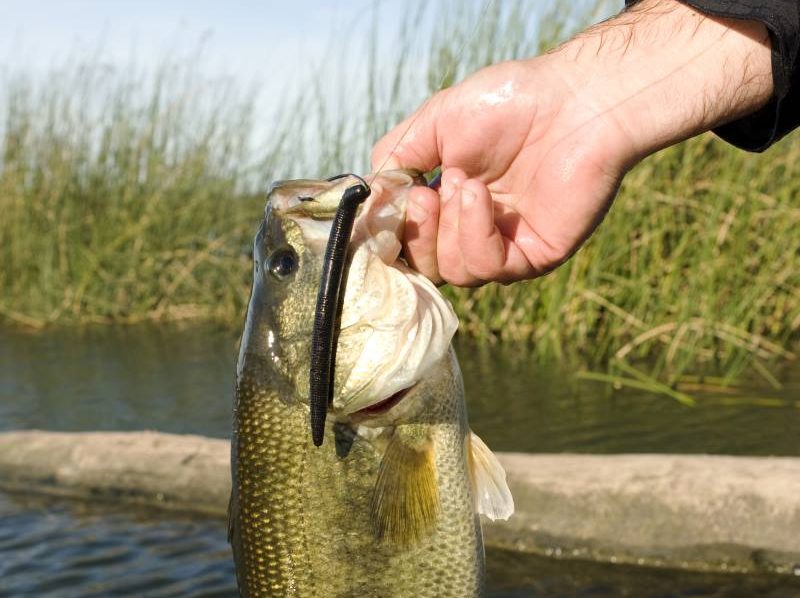5 Hacks for Bass Fishing with Plastics

5 Low Tech Hacks for Soft Plastics and Bass
‘Hacks’ nowadays are defined as a clever solution to a problem. In an era of high-tech gadgetry and complex rigging options here are five decidedly low-tech ideas to consider when fishing soft plastic lures for Largemouth Bass (and other species as well). I have gathered these ideas from a career of talking to guides, tournament professionals, bait shop owners and avid anglers across the country.
Stuffing Tubes-
For as long as I can remember, tubes have been deadly for everything from Lake Trout to Crappie, but Bass in particular are fond of tubes. A refinement I learned years ago is to put a piece of Styrofoam packing peanut up into a tube to make it buoyant. The size of the piece of Styrofoam will be dictated by the size of the hook and of course the size of the tube.
We want just enough float for the tube to be slightly more than neutrally buoyant giving it a slow rise, but also having the tube float as horizontal as possible when fished behind a fixed weight (split shot, pegged bullet sinker or Carolina Rig). A further refinement is the addition of a piece of Alka Seltzer which when introduced to the water will cause it to fizz and give off CO2 in the form of bubbles in the water. Some anglers feel this offers some added visual attraction.
Toothpick Tech–
A film canister filled with wooden toothpicks has been a staple in my tackle bag and on my fishing boat for over 30 years. There are two hacks that I use toothpicks for. The first is for pegging bullet weights by stuffing a toothpick into the rear of the weight and breaking or trimming of the excess. I can create a makeshift Carolina rig by pegging the weight in-line ahead of my presentation (see first hack for a rig option). I can also peg a bullet weight right in front of my hook to create a Texas Rig (great for craws).
The second hack is for pegging my soft plastics to my hook so short striking fish don’t pull the bait down the hook shank and ruin my presentation. In this scenario I run my soft plastic bait (typically a longer worm or creature bait) up the shank of my hook so the end of my soft plastic bait just covers the hook eye. I then stuff a toothpick through the soft plastic and through the eye of the hook and out the other side of the soft plastic. I then break off or trim the toothpick down to remove any excess.
Oiling Baits-
I have some favorite bait shapes and colors that are in heavy rotation on my boat that I buy and store in quantity. Sometimes these baits start to ‘dry out’ and adhere to each other so that when I go to grab a new bait, I end up pulling out two or three that are stuck together.
By adding a small amount of vegetable cooking oil to the bag and mixing the baits up so they all get a light coating, I can easily separate one bait at a time from the pile in the bag. About ½ a teaspoon for a 20-count bag typically does the trick. You don’t need to drown the baits in oil here, less often times is better and cooking oil is neutral so it doesn’t react with the soft plastics. The fish don’t seem to notice the oil and I lose far less appendages on creature baits when pulling them out of the bag as a result.
Rubber Band Aid-
Drop Shotting is a very effective technique for Largemouth Bass (and other species too). One refinement that I have been using for years is to tie a piece of a rubber band to the end of my main line and then onto my dropshot weight. The longer the rubber band, the more wild the action (generally 3-6 inches is standard). This addition creates a ‘bungee’ effect for my presentation that gives my bait incredible action without moving it along the bottom very far.
This system works great for neutral/negative fish or fish that are tight to cover as it really makes the soft plastic lure move very enticingly, but allows it to stay it in the same place on the bottom. A heavier weight at the bottom of this rig (1/16-1/8 oz heavier than what you would normally use) is preferred and a lighter action rod (so you can feel the rubber band elongate) complete this hack.
BBs and the Bullfrog–
I just recently became aware of this last hack and the concept has been a lot of fun to play around with. Everyone I know loves to fish topwater lures when given the chance and bass do love frogs. Sometimes when fishing lily pads or moss mats a largemouth bass will violently blow up on a bait and lighter versions of frogs can get pushed out of the way on the strike and the hook never gets in the fish’s mouth. By fishing heavier frogs or weighing down lighter ones they tend fall into the fish’s mouth resulting in better hookups. Additionally, heavier baits tend to create a better presence by causing the floating vegetation to deflect more signaling a bait’s presence to lurking largemouth bass.
By using a sharp knife to cut a small hole in the back of a hollow frog (this hack only works on hollow frogs) you can add a few BBs to the chamber. Then seal the hole you created using a hot glue gun. I have experimented with small shot from a shotgun shell I carefully opened as well as commercially available BBs for an air-rifle or BB gun which tend to be a little larger. This hack requires a little experimentation on your part as too many BBs will cause the frog to sink and you want it to be buoyant. An added benefit is the addition of sound from the BBs rattling around inside the hollow body of the frog helping hungry bass locate your lure.
Conclusion
In each case, these five hacks will require some refinement for your individual preference and situations. While not a definitive list nor a complete accounting, I offer these ideas as food for thought in hopes of sparking your imagination and creativity as well as helping you to catch more fish this year. Best Wishes and BIG Fishes!!!
by Scott Reed
August 2025
Looking for something to try during the summer
Also here is the Digital Issue August 2025
Looking for our Cattle/Dairy side of things?

